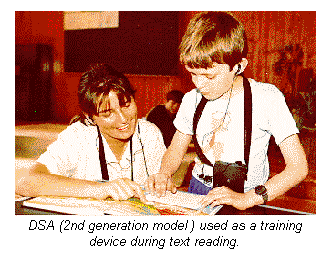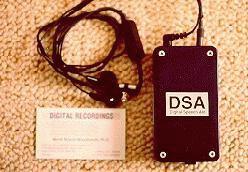|
Stuttering - Some Facts and
Answers
This paper was published in the February/March 1994 edition of the Ability Network magazine and has been recommended by Digital Recordings as suggested reading for their DSA (Digital Speech Aid) product. Copyright 1994-2014, Digital Recordings. All Rights Reserved.
What is Stuttering?
Stuttering is a speech disorder
which manifests itself in the form
of involuntary repetitions,
prolongations and blocks during
speech. These are often accompanied
by facial spasms and body
movements in more severe cases.
Stuttering often leads to embarrassment,
apprehension and fear of loss
of speech control.
Stuttering occurs to various
degrees in about 1% of adults and
about 4% of children (under the age
of 12), which means that, eventually,
some of the children overcame
the disorder. It occurs about four
times more often in males than in
females. The majority of stutterers
can sing and whisper without
problems.
In many cases, stuttering was
believed to be caused by psychological
disorders and nervousness.
This stigma still exists among a
large part of the medical and health
community as well as the general
population.
Low self esteem, nervousness,
and problems in communicating
with other people frequently lead
to dropping out of school, not
being promoted at work etc.
During childhood and, later, in
school, children are the brunt of
teasing. This can cause trauma and
children who are reluctant to
attend school. I believe that most of
these problems are a result of
misconceptions about stuttering.
Coping with stuttering depends
on the particular case and
the environment in which the
person is working and living.
Treatment offered by Speech
Pathologists involves various
techniques to slow down speech,
coordinate speech production with
breathing, change ways of speaking
and pronouncing words etc. It also
involves some counselling and
relaxation therapy which very
often overlaps with work and input
from Psychologists.
These techniques work to a
certain degree and results depend
very much on the particular case.
They tend to work better in a
clinical setting than in the real
world where a person cannot
concentrate as much on speech
production. Unfortunately, many of
these techniques require a conscious effort
on the part of the
stutterer. Many people give up
speech therapy because they feel
that fluent, but unnatural sounding
speech is worse than stuttering
itself. It is estimated that about 5%
to 10% of stutterers are receiving
some form of therapy. The low
numbers are an indication of the
effectiveness of current treatments!
Various other methods were
used in the past to combat stuttering,
including mechanical devices
used in the mouth (marbles, inserts
etc.). These were effective for a
short time only. Newer devices are
based on electronics. In DAF (Delay
Auditory Feedback), the stutterer's
own speech is delayed, forcing
him/her to slow down. Another
device - Edinburgh Masker -
produces a noise which masks the
stutterer's own speech. There are
several similar devices. Some of
them are annoying and not comfortable to use.
If they work for a
particular stutterer, they usually
remain effective over time.
Some people believe that
conscious control of speech is better
than using these devices. I disagree.
If stuttering is indeed a physiological
disorder (with a
neurological basis in most cases),
telling a person to control it does
not make much sense. It is like
telling people with faulty vision to
take off their glasses and concentrate
to see better.
Similarly, if somebody has a
hearing disorder and requires a
hearing aid to hear normal conversation -
what will happen if we ask
this person to take out his hearing
aid and concentrate in order to
hear? But this is exactly what
stutterers are often told - concentrate,
relax, use certain techniques
and everything will be fine. Unfortunately,
it only works in certain
cases. What about the others? They
are told, that they have to concentrate
and practice more. When they
fail, this leads to further frustration,
and more deterioration of self-image and self-esteem.
"If others
can do it and I cannot, it means that
I am a weaker person."
Another interesting fact associated
with this and supporting the
notion that the disorder is physiological
in nature is that hypnotic
therapy does not have lasting long-
term effects. A mental function'
which could be controlled consciously,
should be very susceptible
to hypnotic therapy.
Stutterers become nervous (in
the opinion of Digital Speech Aid
inventors), because they stutter (not
as believed by some, that they
stutter because they are nervous).
There are profound implications
underlying these very different
understandings.
Several years ago I started a
series of experiments to uncover
the mechanisms which cause
stuttering and to find some techniques
to compensate for this
physiological (as I contend) deficiency of speech.
After reading the
literature and talking to several
experts in the field, I realized that
very little is known about stuttering
and even less is understood. I was
stunned by the many misinterpretations of the facts and
experimental results.
It became obvious to me later
why this is so - simply put, the
majority of people in the field of the
Speech Pathology have very little
background in math, physics,
acoustics, electronics and signal
processing.
Therefore, my new approach
and interpretations were met with
skepticism in some cases and with
hostility in others.
The culmination of my new
approach was a better understanding
of the stuttering disorder. And
understanding always leads to
discovery and to new inventions.
A very talented Polish professor,
Dr. Andrzej Czyzewski from
Technical University of Gdansk,
Poland helped to put this understanding
of stuttering disorders
into practice. Together we have
designed the most sophisticated
device to date - Digital Speech Aid.
Since this device is under patent at
the present time, I cannot elaborate
on exactly how it works.
DSA is aimed to correct "classical
stutterers" who are
characterized by the usual patterns
of stuttering, have no problem with
speech synthesis and do not stutter
during whispering. Subjects outside
of this group can also benefit
in some cases, but results are less
predictable.
DSA is perfectly safe. It is an
acoustical device which puts out
low-intensity acoustical signals into
stutterers' ears via a standard
Walkman-type set of earphones.
Furthermore, the output of the
device is protected from overload,
making this safer than personal
stereos and Walkmans.
DSA is a small, sophisticated,
battery operated, electronic device
using a microphone and a pair of
earphones. It is most effective in the
case of 'Classical Stutterers" who
make up about 80% to 90% of the
stuttering population. Significant
improvement or total fluency has
been observed in 40% to 60% of
"Classical Stutterers". The rest have
shown some degree of improvement.
We are making real life tests
of the device, and improvements
were observed in all situations: in
the office, at home, on the telephone,
during public meetings,
presentations, good and bad days,
etc. There is an immediate improvement;
however, we observe
an increase in effectiveness during
the first 3 to 4 weeks. After that
there is little change.
There seems to be some
carryover effect as the person
remams fluent for about 2 to 6
hours after using DSA in some
cases. We have also observed
significant improvements in self-esteem
and confidence. People like
DSA and say that it is relaxing.
Long term effects seem to
support our theory and expectations.
DSA is still effective at the
same level after three months of
use. It is a kind of prosthetic device,
only it does not have to be worn all
the time.
Our theory and data have not
yet been published. DSA is to be
patented internationally, and we
are presently developing an International
Research Program for DSA
testing. The initial results are good,
but further testing will be required
to substantiate our claims.
The first prototypes of DSA
were finished in May 1992. Some of
the first clinical trials were very
exciting and the device met with
approval from people with a
stuttering disorder. The following
testimony from a speech pathologist is typical:
" ...I think that
Digital Speech Aid (DSA)is extremely effective in
the elimination
of stuttering, even in cases of very
severe stuttering. ... During my
30-years long practice as a speech
pathologist, no technique was as
successful. I believe that we finally
have the green light for people who
have till now problems with
elimination of stuttering. ... We are
waiting very anxiously for DSA to
appear on the market and become
available for all stuttering people ..."
Halina Stawikowska, Speech
Pathologist, June 4, 1992. Trials
conducted in 1993 in Canada have
yielded equally enthusiastic results.
I believe that we are very close to an explanation of the stuttering disorder. My hope is that scientists from different fields will join together to advance our knowledge of this disorder and its treatment. Without this approach progress will be as slow as in the last several decades. Terms of Use | Return Policy | Privacy Policy
No part of the information provided on this www page may be reproduced for any purpose, in any form, without prior written approval.
|

